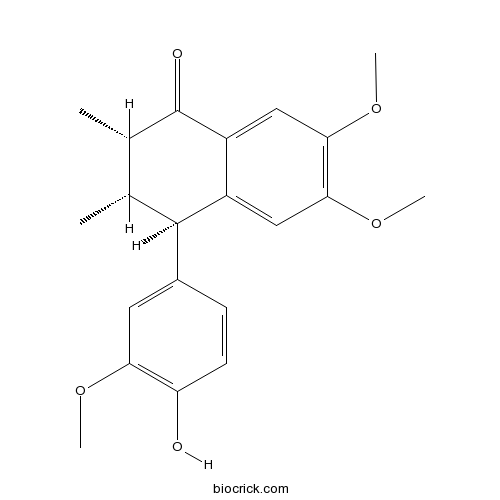(-)-HolostyligoneCAS# 887501-28-2 |

Quality Control & MSDS
3D structure
Package In Stock
Number of papers citing our products

| Cas No. | 887501-28-2 | SDF | Download SDF |
| PubChem ID | 46883472 | Appearance | Cryst. |
| Formula | C21H24O5 | M.Wt | 356.41 |
| Type of Compound | Lignans | Storage | Desiccate at -20°C |
| Solubility | Soluble in Chloroform,Dichloromethane,Ethyl Acetate,DMSO,Acetone,etc. | ||
| Chemical Name | (2S,3S,4R)-4-(4-hydroxy-3-methoxyphenyl)-6,7-dimethoxy-2,3-dimethyl-3,4-dihydro-2H-naphthalen-1-one | ||
| SMILES | CC1C(C(=O)C2=CC(=C(C=C2C1C3=CC(=C(C=C3)O)OC)OC)OC)C | ||
| Standard InChIKey | LBJCQKYBKIAWHJ-XAAFQQQXSA-N | ||
| Standard InChI | InChI=1S/C21H24O5/c1-11-12(2)21(23)15-10-19(26-5)18(25-4)9-14(15)20(11)13-6-7-16(22)17(8-13)24-3/h6-12,20,22H,1-5H3/t11-,12+,20-/m1/s1 | ||
| General tips | For obtaining a higher solubility , please warm the tube at 37 ℃ and shake it in the ultrasonic bath for a while.Stock solution can be stored below -20℃ for several months. We recommend that you prepare and use the solution on the same day. However, if the test schedule requires, the stock solutions can be prepared in advance, and the stock solution must be sealed and stored below -20℃. In general, the stock solution can be kept for several months. Before use, we recommend that you leave the vial at room temperature for at least an hour before opening it. |
||
| About Packaging | 1. The packaging of the product may be reversed during transportation, cause the high purity compounds to adhere to the neck or cap of the vial.Take the vail out of its packaging and shake gently until the compounds fall to the bottom of the vial. 2. For liquid products, please centrifuge at 500xg to gather the liquid to the bottom of the vial. 3. Try to avoid loss or contamination during the experiment. |
||
| Shipping Condition | Packaging according to customer requirements(5mg, 10mg, 20mg and more). Ship via FedEx, DHL, UPS, EMS or other couriers with RT, or blue ice upon request. | ||
| Structure Identification | J Nat Prod. 2010 Nov 29;73(11):1933-7.Microbial transformations of aryltetralone and aryltetralin lignans by Cunninghamella echinulata and Beauveria bassiana.[Pubmed: 20961092]
|

(-)-Holostyligone Dilution Calculator

(-)-Holostyligone Molarity Calculator
| 1 mg | 5 mg | 10 mg | 20 mg | 25 mg | |
| 1 mM | 2.8058 mL | 14.0288 mL | 28.0576 mL | 56.1151 mL | 70.1439 mL |
| 5 mM | 0.5612 mL | 2.8058 mL | 5.6115 mL | 11.223 mL | 14.0288 mL |
| 10 mM | 0.2806 mL | 1.4029 mL | 2.8058 mL | 5.6115 mL | 7.0144 mL |
| 50 mM | 0.0561 mL | 0.2806 mL | 0.5612 mL | 1.1223 mL | 1.4029 mL |
| 100 mM | 0.0281 mL | 0.1403 mL | 0.2806 mL | 0.5612 mL | 0.7014 mL |
| * Note: If you are in the process of experiment, it's necessary to make the dilution ratios of the samples. The dilution data above is only for reference. Normally, it's can get a better solubility within lower of Concentrations. | |||||

Calcutta University

University of Minnesota

University of Maryland School of Medicine

University of Illinois at Chicago

The Ohio State University

University of Zurich

Harvard University

Colorado State University

Auburn University

Yale University

Worcester Polytechnic Institute

Washington State University

Stanford University

University of Leipzig

Universidade da Beira Interior

The Institute of Cancer Research

Heidelberg University

University of Amsterdam

University of Auckland

TsingHua University

The University of Michigan

Miami University

DRURY University

Jilin University

Fudan University

Wuhan University

Sun Yat-sen University

Universite de Paris

Deemed University

Auckland University

The University of Tokyo

Korea University
- Fmoc-Arg(Mts)-OH
Catalog No.:BCC3075
CAS No.:88743-97-9
- INCB 3284 dimesylate
Catalog No.:BCC1646
CAS No.:887401-93-6
- 3,9-Dihydroeucomin
Catalog No.:BCN6832
CAS No.:887375-68-0
- K-115
Catalog No.:BCC5500
CAS No.:887375-67-9
- Hebeirubescensin H
Catalog No.:BCN7155
CAS No.:887333-30-4
- Epiglobulol
Catalog No.:BCN7121
CAS No.:88728-58-9
- Adynerigenin beta-neritrioside
Catalog No.:BCN4556
CAS No.:88721-09-9
- 1alpha-Hydroxytorilin
Catalog No.:BCN6648
CAS No.:887147-75-3
- Borneol 7-O-[beta-D-apiofuranosyl-(1->6)]-beta-D-glucopyranoside
Catalog No.:BCN7814
CAS No.:88700-35-0
- Neobritannilactone B
Catalog No.:BCN3510
CAS No.:886990-00-7
- Piperlotine C
Catalog No.:BCN6485
CAS No.:886989-88-4
- Liranaftate
Catalog No.:BCC4672
CAS No.:88678-31-3
- Bafetinib (INNO-406)
Catalog No.:BCC4036
CAS No.:887650-05-7
- Gaudichaudic acid
Catalog No.:BCN3071
CAS No.:887923-46-8
- Isogambogenic acid
Catalog No.:BCN3076
CAS No.:887923-47-9
- Gambogoic acid B
Catalog No.:BCN7936
CAS No.:887923-50-4
- Galanin (porcine)
Catalog No.:BCC5960
CAS No.:88813-36-9
- Ganetespib (STA-9090)
Catalog No.:BCC2336
CAS No.:888216-25-9
- 11,12-De(methylenedioxy)danuphylline
Catalog No.:BCN4436
CAS No.:888482-17-5
- Sprengerinin C
Catalog No.:BCN6657
CAS No.:88861-91-0
- Adrenorphin, Free Acid
Catalog No.:BCC1011
CAS No.:88866-92-6
- Sprengerinin A
Catalog No.:BCN6658
CAS No.:88866-99-3
- Fosinopril sodium
Catalog No.:BCC2141
CAS No.:88889-14-9
- Inulanolide A
Catalog No.:BCN3705
CAS No.:888941-86-4
Microbial transformations of aryltetralone and aryltetralin lignans by Cunninghamella echinulata and Beauveria bassiana.[Pubmed:20961092]
J Nat Prod. 2010 Nov 29;73(11):1933-7.
Microbiological transformation of the aryltetralone lignan (-)-8'-epi-aristoligone (1) with Cunninghamella echinulata ATCC 10028B afforded two known natural lignans, (-)-Holostyligone (3) and (-)-arisantetralone (4). Incubation of the aryltetralin lignan (-)-isogalbulin (2), obtained by chemical transformation of 1, with C. echinulata ATCC 10028B afforded the known lignan aryltetralol (5) and seven new metabolites, (-)-8-hydroxyisogalbulin (6), (-)-7-methoxyisogalbulin (7), (-)-4'-O-demethyl-8-hydroxyisogalbulin (8), (-)-7-methoxy-8-hydroxyisogalbulin (9), (-)-4'-O-demethyl-7-methoxyisogalbulin (10), (-)-4',5-O-didemethylcyclogalgravin (11), and (-)-4'-O-demethylcyclogalgravin (12). When 2 was subjected to biotransformation with Beauveria bassiana ATCC 7159, (-)-8-hydroxyisogalbulin (6) was the only isolable product. The structures of all new compounds were established by detailed analysis of their spectroscopic data.


